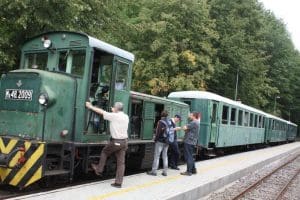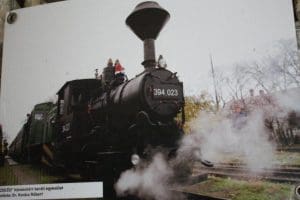
At the forest destination.
All aboard Zsuzsi – the historic narrow-gauge train that chugs deep into the forests of eastern Hungary
By James Brewer
Children and adults alike cheer and wave as the train nicknamed Zsuzsi (Susie) departs from a neat, one-platform station in a quiet suburb of Debrecen, Hungary’s second city. With Zsuzsi running for her first few kilometres on track parallel to the highway, she keeps motorists and their passengers spellbound by the evocation of a great railway age.
We on board are the lucky ones who will enjoy a romantic journey deep into the woods and far from the homes, factories and yards of urban civilisation.

Zsuzsi’s home station.
It is a wonderful day out for youngsters – just as they are enthralled by the better-known adventures of Thomas the Tank Engine – and fans of narrow gauge railways across Europe find this ride just as exciting.
This is the real, and rail, thing. Zsuzsi Scenic Railway is named after the original 107 horsepower steam locomotive that ran on a 950 mm gauge line, construction of which began in 1882, out of Debrecen.
Zsuzsi was Hungary’s first narrow-gauge train, built to haul timber for a company named Gúth. Although local people anxious about the noise of the project had objected to construction of the line, wood-burning locomotives inaugurated the project as planned. The first 20 km per hour steam locomotive was built by the Munich factory Krauss & Co.

Here comes our train!
Coal-fired trains took over in 1909. Passenger traffic began in 1923 at a speed of up to 35 km per hour. The line was heavily damaged during World War II, but quickly resumed service, in 1946. With the economy still on a war footing, the fare for travelling 20 km was six eggs.
Under nationalisation in 1949, the Hungarian state rail company MÁV carried out major improvements, and diesel locomotives were introduced in 1955. The line’s worst day was in the mid-1950s when two passenger trains collided. Recorded details of this accident have somehow disappeared.
The 950 mm gauge became problematic from an equipment supply and maintenance standpoint, and in 1961 rebuilding was carried out to 760 mm standard. The old carriages and locomotives including the original Zsuzsi were scrapped in favour of Mk48 locomotives.

Zsuzsi arrives.
Passenger traffic was strong in the 1970s, with the five-car trains packed. Plans to close the service led to protests, and a 16 km section was preserved. Freight transport was axed in 1977, and regular passenger services ceased, but part of the line continued to be operated as a tourist railway until 1995.There was another big uproar in 1995, against a new plan to eliminate the line, and the following year it was taken over by a new organisation consisting mainly of retired railwaymen.

Engine of the East
We join crowds lining the platform at the station of Hétvezér utca, a street a 10-minute bus ride from Debrecen city centre, and soon Zsuzsi, with its three green passenger carriages pulls in. There is a scramble to get on, but it turns out that there is plenty of room for everyone to settle into the wooden seats, and on schedule Zsuzsi rattles off through the quiet outskirts of the city. The locomotive emits frequent whistles to warn of its approach: for those on board it is a rather comforting sound. We are on our way!
We are bound for the forest outpost of Hármashegyalja. After a few minutes, we can see that the soil of the region is typically sandy, and we are lost in a succession of acacia, pine groves and oak forests. There are glimpses of arable land, and occasionally farms. We pass some lonely intermediate stations, but like most other people on board we are keen to continue our journey to the terminus.

Take your seats!
We pass a place named Csereerdő, near which, we learn, is an ancient system of trenches – and there is a maritime story behind their construction! According to legend, Prince Csörsz – son of the King of the Transylvanian Alps – was faced with a seemingly impossible task before he could marry the princess he wooed, who was the daughter of the King of the Southern Sea. The king granted permission for the marriage on condition that Csörsz voyaged from landlocked Transylvania to claim his bride with a fleet of ships and take her back by sea.
How was the prince to do that, over dry land? Proving that love knows no bounds, Csörsz called the Devil in aid. It took just one night for the Devil to dig a canal from the mountains to the Danube, and from there to the sea. After Csörsz collected his bride, most of the waterway dried up. That is why the canal was called Ördögárok (the Devil’s Ditch). In fact, Ördögárok is what remains from the 7th century of a line of fortresses between the Rivers Danube and Tisza.

Age of steam photo by Dr Róbert Kovács.
After 55 minutes we pull in smoothly at the tidy station of Hármashegyalja, where there are displays of the history of the line, children’s paintings of Zsuzsi, and an observation tower. It is a pleasant short walk to a large clearing with a picnic area, where on an open-air stage circus clowns and stilt walkers are entertaining the kids, and disco music is blasting. There are stalls grilling sausages and serving other refreshments. We are lucky: such attractions are not here permanently, only when there is a festival or a special event.

A junior view of Zsuzsi.
There are hiking trails and on the crest of a small hill there is a dizzyingly tall lookout tower.
It is a perfect summer’s day out for everyone, and a tribute to the hard work of the enthusiasts, who maintain the line and hope to extend the line to other villages with typical names of the region –Nyirmartonfalva, Nyiracsad, and Nyirbeltek – and to restore the original home terminus, which was a timber yard.
The care that has been lavished on this once-doomed Zsuzsi rail line is an inspiration for everyone in Europe and worldwide who cares about railway heritage. The dedication of the volunteer staff, the respect for the cleanliness and tidiness of the carriages shown by the passengers, and the unalloyed delight of the children shows that most people appreciate the ‘service’ – and in this case environmentally-friendly – benefits of excursion train travel.

Horse-power in the forest.





